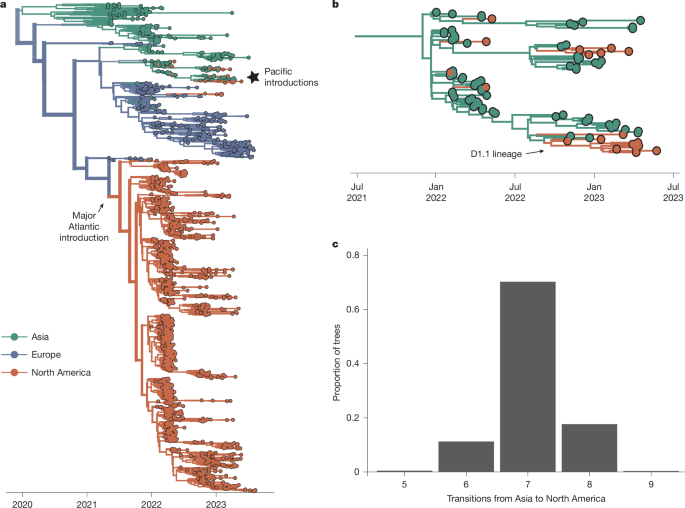
"Since emerging in 1996, highly pathogenic H5N1 viruses of the A/goose/Guangdong lineage have spread globally through enzootic transmission in domestic poultry in Asia and Africa, paired with occasional cross-continental movement by wild birds of the Anseriformes (ducks, geese, swans) and Charadriiformes (shorebirds) orders3,4,5,6,7,8,9. In 2005, introduction of poultry-derived H5N1 viruses into wild birds in China led to viral dispersal across Northern Africa and Asia, establishing new lineages of endemic circulation in poultry10,11."
"In December 2021, clade 2.3.4.4b HPAI H5N1 viruses were introduced and spread across the Americas, causing a panzootic of considerable morbidity and mortality in wild and domestic animals. In contrast to past North American epizootics, domestic bird culling has not halted detections, and morbidity and mortality has been widespread across wild avian and mammal species not usually impacted by HPAI15,16,17,18,19,20, raising the possibility that new reservoir hosts could be established that should be actively surveilled."
Highly pathogenic H5N1 viruses of the A/goose/Guangdong lineage emerged in 1996 and spread globally through enzootic transmission in domestic poultry in Asia and Africa, with occasional cross-continental movement by wild Anseriformes and Charadriiformes. Poultry-derived H5N1 introductions into wild birds in 2005 led to dispersal across Northern Africa and Asia and establishment of endemic poultry lineages. In 2014, migratory birds carried H5N8 from Europe to North America, prompting the culling of over 50.5 million commercial birds and eventual outbreak extinction due to lack of wild-bird persistence. Since December 2021, clade 2.3.4.4b HPAI H5N1 has spread across the Americas, causing a panzootic with broad host impact and continued detections despite culling; Europe has experienced seasonal outbreaks, frequent reassortment, and expanded wild-bird involvement.
Read at Nature
Unable to calculate read time
Collection
[
|
...
]